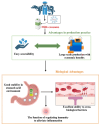Antioxidant Potential of Exosomes in Animal Nutrition
- PMID: 39199210
- PMCID: PMC11351667
- DOI: 10.3390/antiox13080964
Antioxidant Potential of Exosomes in Animal Nutrition
Abstract
This review delves into the advantages of exosomes as novel antioxidants in animal nutrition and their potential for regulating oxidative stress. Although traditional nutritional approaches promote oxidative stress defense systems in mammalian animals, several issues remain to be solved, such as low bioavailability, targeted tissue efficiency, and high-dose by-effect. As an important candidate offering regulation opportunities concerned with cellular communication, disease prevention, and physiology regulation in multiple biological systems, the potential of exosomes in mediating redox status in biological systems has not been well described. A previously reported relationship between redox system regulation and circulating exosomes suggested exosomes as a fundamental candidate for both a regulator and biomarker for a redox system. Herein, we review the effects of oxidative stress on exosomes in animals and the potential application of exosomes as antioxidants in animal nutrition. Then, we highlight the advantages of exosomes as redox regulators due to their higher bioavailability and physiological heterogeneity-targeted properties, providing a theoretical foundation and feed industry application. Therefore, exosomes have shown great potential as novel antioxidants in the field of animal nutrition. They can overcome the limitations of traditional antioxidants in terms of dosage and side effects, which will provide unprecedented opportunities in nutritional management and disease prevention, and may become a major breakthrough in the field of animal nutrition.
Keywords: animal nutrition; antioxidants; exosome; milk exosome; oxidative stress.
Conflict of interest statement
The authors declare no conflict of interest.
Figures



Similar articles
-
Cellular and exosome mediated molecular defense mechanism in bovine granulosa cells exposed to oxidative stress.PLoS One. 2017 Nov 8;12(11):e0187569. doi: 10.1371/journal.pone.0187569. eCollection 2017. PLoS One. 2017. PMID: 29117219 Free PMC article.
-
Mycobacterium tuberculosis Reactivates HIV-1 via Exosome-Mediated Resetting of Cellular Redox Potential and Bioenergetics.mBio. 2020 Mar 3;11(2):e03293-19. doi: 10.1128/mBio.03293-19. mBio. 2020. PMID: 32127457 Free PMC article.
-
Emerging Antioxidant Paradigm of Mesenchymal Stem Cell-Derived Exosome Therapy.Front Endocrinol (Lausanne). 2021 Nov 29;12:727272. doi: 10.3389/fendo.2021.727272. eCollection 2021. Front Endocrinol (Lausanne). 2021. PMID: 34912294 Free PMC article. Review.
-
Redox Systems Biology of Nutrition and Oxidative Stress.J Nutr. 2019 Apr 1;149(4):553-565. doi: 10.1093/jn/nxy306. J Nutr. 2019. PMID: 30949678 Free PMC article.
-
Treatment of Oxidative Stress with Exosomes in Myocardial Ischemia.Int J Mol Sci. 2021 Feb 9;22(4):1729. doi: 10.3390/ijms22041729. Int J Mol Sci. 2021. PMID: 33572188 Free PMC article. Review.
Cited by
-
Oxidative Stress, Gut Microbiota, and Extracellular Vesicles: Interconnected Pathways and Therapeutic Potentials.Int J Mol Sci. 2025 Mar 28;26(7):3148. doi: 10.3390/ijms26073148. Int J Mol Sci. 2025. PMID: 40243936 Free PMC article. Review.
-
Redox status of biomarkers in serum of dogs with hypothyroidism and its treatment with levothyroxine sodium.Front Vet Sci. 2025 Apr 4;12:1490369. doi: 10.3389/fvets.2025.1490369. eCollection 2025. Front Vet Sci. 2025. PMID: 40256603 Free PMC article.
References
Publication types
Grants and funding
LinkOut - more resources
Full Text Sources
Research Materials

